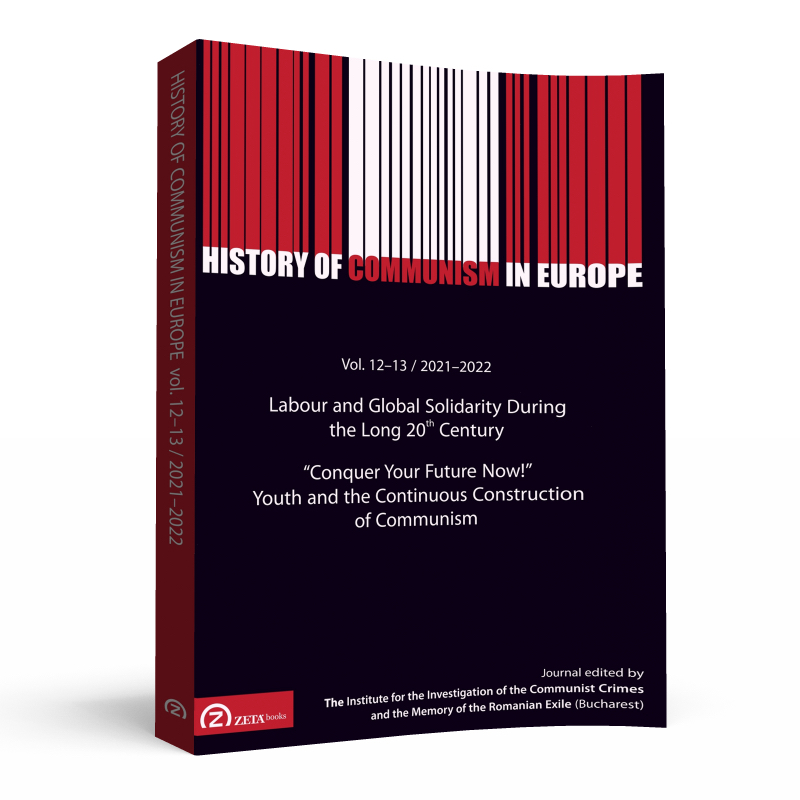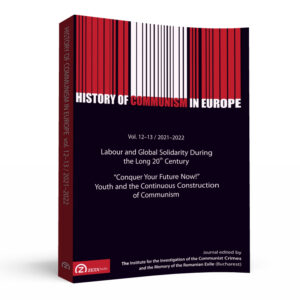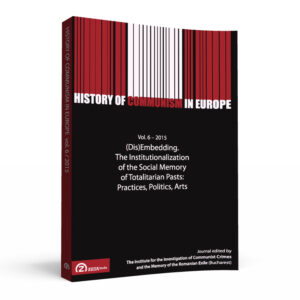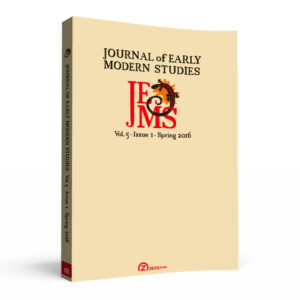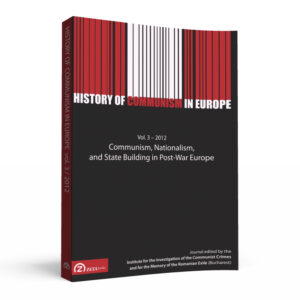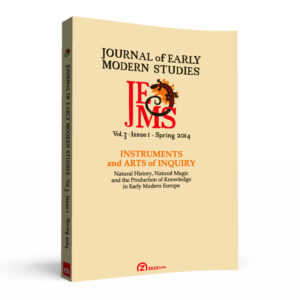History of Communism in Europe, vol. 12–13 / 2021–2022
TABLE OF CONTENTS
Editors’ Note
LABOUR AND GLOBAL SOLIDARITY DURING THE LONG 20th CENTURY
Dalia BÁTHORY, Editor’s Introduction: Socialist Solidarity and East-East Relations in the 20th Century
Abstract: The current section of issues 12/2021-13/2022 of History of Communism in Europe deals with East-East and East-South relations among socialist countries and countries of the Global South. Exploring local specificities and global ambitions, the papers bring to light the beginnings of the socialist developmental projects, and bilateral relations that overcome the strict framework of the monolithic socialist bloc.
Božica SLAVKOVIĆ MIRIĆ: Drač-Elbasan Railway – “Railway of the Yugoslav-Albanian Brotherhood”
Abstract: After the end of World War II, Yugoslavia and Albania continued the cooperation that had been established during the war. The economic cooperation between the two countries began after the signing of the Friendship and Assistance Agreement in mid-1946. Part of the cooperation was joint ventures between the two countries and one of them was a railway company. The first Albanian railway, Drač-Elbasan, represented the result of Yugoslav-Albanian reconciliation. Its construction began in early 1947 and was completed in November of the same year. A plan for the Drač-Tirana railway also existed and was to be implemented as a joint project, but due to the crisis of the relations between the two countries, it never materialized. Yugoslavia and Albania discontinued their cooperation after Albania accepted the Informbureau Resolution in mid-1948.
Daniel FILIP-AFLOAREI: The “Solidarity” Crisis and the Poles of Suceava in the ’80s
Abstract: In this paper, I will explore the relationship between the Romanian Socialist leadership and the Polish minority in Suceava after the outbreak of the “Solidarity” crisis, in August 1980. Although the Polish community in Suceava was small, it had close connections with the Polish tourists who visited Romania, whose number reached almost one million every year in the early ‘80s. These connections aroused many suspicions among the authorities in Bucharest. Particularly, this paper has three major objectives: it investigates the extensive surveillance campaign targeting the Polish minority in Suceava after the emergence of the “Solidarity” Trade Union in Poland, it analyses the methods used by the Communist authorities to counteract the alleged effects of this crisis and it depicts the Romanian leadership’s perception of the Polish crisis of the ‘80s, beyond the official statements. Ultimately, as a general framework of this paper, I will study the bilateral relations between Romania and Poland. To these ends, I will use the archives of the National Council for the Study of Securitate Archives, corroborated with sources from the National Archives and the consular reports of the Romanian Embassy in Warsaw. For a more informed perspective, I will also employ information from the Archives of Poland’s Ministry of Foreign Affairs. The interviews featuring the persons with Polish contacts or monitored by the Securitate will complete the documentary sources.
Dalia BÁTHORY: Romanian Solidarity with Countries of the Global South. Development, Trade, Training
Abstract: This paper deals with the Romanian experience as a developer of projects and investor of resources in the countries of the Global South during the 1970s. It follows the country’s grand narrative in its Communist Party’s documents, as compared to that of the statements of the international meetings of the communist parties in the 1960s and 1970s and to that present in the party’s newspaper Scinteia, and in contrast to documents of the political executive committee of the Romanian Communist Party collected from the Romanian National Archives and the Council for the Study of the Securitate Archives. The purpose of this research is to analyse the Romanian solidarity messages in the party discourse, their degree of compliance with the solidarity messages of the rest of the countries in the socialist camp, actual actions of humanitarian assistance in the countries of the Global South, and how those actions and messages were filtered and transmitted to the Romanian readers of print press. The results indicate a discrepancy between public discourse and archival discourse on the one hand, and the nature of information disclosed to the public, on the other.
„CONQUER YOUR FUTURE NOW!” YOUTH AND THE CONTINUOUS CONSTRUCTION OF COMMUNISM
Daniel FILIP-AFLOAREI: Editor’s Introduction: Youth in Communism: Between Compliance and Deviance
Abstract: All research agrees that youth was an important social category for the communist regimes. At the beginning of the Cold War, youth was perceived in literature as a subject under the regimes’ total control. Later on, scholars understood that gaining the support of young people was a political priority for the Communists. To follow this complicated relationship between youth and the communist regime, I first looked at the complexity of the concept. Second, I have moved beyond the Manichean perspective of the Cold War and sought to study it in its complexity and continuity within generations. Ultimately, this contextualisation helps readers better understand the works in the current issue, which examines the problem of youth from several perspectives.
I. Youth Subcultures
Adrian POPAN: Rock’n’Roll and the Discontents of Communism: The Scandals that Rocked the Scene
Abstract: The literature on rock music in socialism oscillates between presenting it in opposition to the socialist society and being part of it. This article tackles the same question by looking at the moments where rock musicians found themselves at odds with mainstream morality: the scandals. Three cases have been selected for analysis: the media campaign against the band Chromatic in 1970, the publication of Ceauşescu’s Theses of July in 1971, and the continuing stream of defectors, including from the rock music scene. The analysis concludes that both sides tended to avoid open confrontations. Rock musicians were no dissidents; they preferred to make music using the available institutional means. Authorities would rather close an eye to problematic events to keep up appearances. Mid-level authorities served as mediators while working for their own benefit.
Sofia LOPATINA: Courtyard Groups: Youth Collective Practices and Soviet Visions of Social Control
Abstract: This article takes a closer look at two seemingly contradictory developments of the early 1960s – the broadening of socialist participation and proliferation of social control – and their impact on young people. It also aims to go beyond the state-society dichotomy by introducing the concepts of youth collective practices and control culture. The analysis will show that multiple state and non-state agents controlled courtyard groups. They developed different, contesting interpretations and practices. While the courtyard groups were diverse and many of them did not break any laws, the agents of control culture viewed them as deviant. However, it was not only the apparent or supposed “deviance” of some courtyard groups that put them in the spotlight but also their uncontrollability and estrangement from Soviet leisure venues and practices.
II. The Young and the System
Cristian VASILE: Albatros – a Publishing House for the Romanian Communist Youth, 1970–1989
Abstract: This paper examines the profile of the Albatros Publishing House in Bucharest (specialising in youth literature) and the activity of its director, writer Mircea Sântimbreanu. He held this position for almost two decades and recounted his experience in a volume of memoirs. I tried to explore these memoirs mainly in parallel with accounts from archival documents and secondary literature. The Albatros Publishing House was a micro-universe for assessing the impact of successive ideological offensives by the Romanian Communist Party on book production and on the youth in general (mainly the July 1971 Theses and the other party directives of the 1970s, as well as the Mangalia Theses of 1983). By the 1980s, the regime’s propaganda had acquired ultra-nationalistic nuances. This paper will also exemplify such developments by discussing the scandal generated by the 1983 publication of Saturnalii by Corneliu Vadim Tudor, a volume of poems with strong antisemitic tenor. Using mainly diaries, journals, secondary literature and archival documents, this article also analyses the strategies deployed by the communist regime in order to coerce the young generation – through the agency of publishing houses – to assume the new literary-political ideology of revolutionary humanism (the Socialist Realism of the Ceaușescu era).
Lucica Nicoleta PĂCURAR: S.R. Romania’s Western Border – the Battlefield between Two Categories of Young People: The Fugitives and the Border Guards
Abstract: The young generation of the ’80s was born and entirely educated under communist ideology. And yet indoctrination failed for some of these young people, who saw the West as a symbol of a better society to aspire to. In order to escape from S.R. Romania, some of them risked their lives in the “adventure” of crossing the border illegally. The main opponents of the fugitives, the border guards, were part of the same age group. In many cases, they behaved brutally toward the fugitives. Did they come to see them as traitors, or was it just the context in which this adversity manifested itself mixed with the soldiers’ fear of their superiors’ punishments? The study is part of a more extensive research regarding the phenomenon of illegal border crossing during Ceaușescu`s dictatorship. Through this study, I aim to analyse the two situations in which some of the young people of the ’80s could find themselves: opponents of the regime (when fleeing to the West was a form of protest) and involuntary “servants” of the system, such as border soldiers, respectively. Also, I focused on identifying the reasons for the conflict between the two categories of young people belonging to the same generation.
III. Youth and Spirituality
Iulia CINDREA NAGY: “The Propagandists are Younger Women”: How Old Calendarist Women Contributed to the Forging of a Religious Identity
Abstract: The 1924 Church reform, through which the Romanian Orthodox Church decided to adopt the Revised Julian Calendar, led to dissent movements, mostly comprised of peasants, especially in the villages of Moldavia and Bessarabia. Considering the calendar change a heresy, these groups soon developed into religious communities that came to be known as Old Calendarists, or “stylists,” followers of “the old-style calendar.” Led by defrocked priests and monks who rejected the reform, the groups very quickly became the target of the secret police and the Gendarmerie. What also drew the attention of the authorities and the Orthodox Church was that women, especially the younger ones, seemed to play important roles within the communities, not only in terms of membership, but also in preserving and spreading the Old Calendarists’ beliefs and religious ideas. As many members of the communities were being arrested, and their churches were destroyed, these women also suffered imprisonment, monastic incarceration, or were forced to hide from the authorities in caves or huts that they built in the woods. Though subjected to various forms of persecution, which continued through the communist period, the majority of them held strong to their beliefs and contributed to the forging of a religious identity. Using archival documents, in the forms of letters, postcards, photos, and declarations as primary sources, and drawing on interviews conducted with contemporary nuns and members of the Old Calendarist communities, the present article explores the personal stories of young Old Calendarist women. Building upon the work of Anca Șincan, this article challenges the notion that transmission of religion was the exclusive prerogative of older women.
Ioana URSU: To be Young and Spiritual during Times of Communism: Students and the Burning Bush of Antim
Abstract: The “Burning Bush” was the name of a cultural circle in Bucharest in the 1940s, comprised of clergy and intellectuals who met periodically to discuss theology, philosophy, literature and to learn about prayer. Some of the most significant members of this group were arrested during the second repressive wave by the Romanian communist regime (1958); along with twelve elderly monks and intellectuals, four students who kept in touch with them were also arrested. Their names were George Văsâi, Șerban Mironescu, Nicolae Rădulescu, and Emanoil Mihăilescu. Using memoirs, oral history interviews and documents from the Securitate archives, the paper will address the interactions between the young students and the elder members of the Burning Bush group of clergy and intellectuals. The narratives of the informative and criminal files of the Securitate regarding the content of their meetings will also be depicted, all inside a larger context of the regime’s repressive measures and relations with the Romanian Orthodox Church.
ISSN 2069-3192 (paperback)
ISSN 2069-3206 (electronic)

